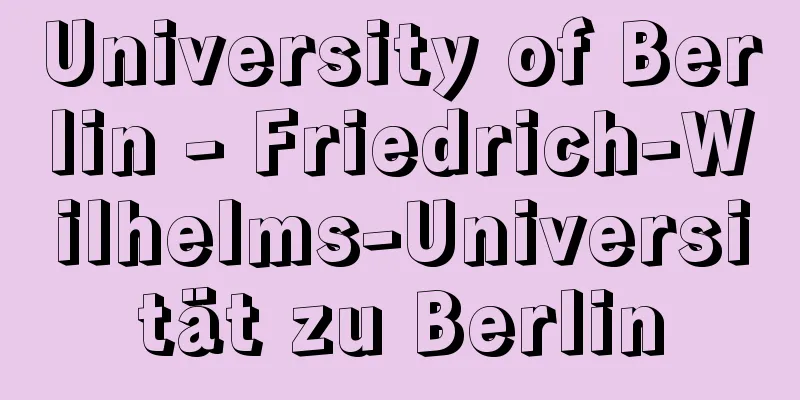University of Berlin - Friedrich-Wilhelms-Universität zu Berlin

|
A representative university of the Federal Republic of Germany. Founded in Berlin, the capital of Prussia, in the early 19th century, it quickly became Germany's leading university and had a great influence on the world as a model for modern universities. After losing the Battle of Jena in 1806, Prussia embarked on educational reform, and in 1809 King Frederick William III issued a decree to establish the University of Berlin. The task of establishing the university was entrusted to W. V. Humboldt, then Secretary of Religious Affairs and Public Education. Humboldt inherited and developed the theories of university and academics of Fichte and Schleiermacher, and made Lehrfreiheit (freedom of teaching) and Lernfreiheit (freedom of learning) unconstrained by political power the principles of the university's founding. He also placed importance on the Faculty of Philosophy from the standpoint of the organic unity of the sciences, and positioned it on an equal footing with the traditional faculties of Theology, Law, and Medicine. The university, which opened in 1810, had world-renowned scholars such as Schleiermacher (theology), Friedrich August B. Biener (law), Hufeland (medicine), and Fichte (philosophy) as deans under its first rector, Theodor Anton Heinrich Shmalz (1760-1831), and the university's fame spread throughout Germany. Furthermore, this German university model, with the idea of "academic freedom" (Akademische Freiheit) at its core, had a major influence on universities in other European countries, the United States, Japan, and other countries in the 19th and 20th centuries. [Toru Magose] Humboldt UniversityDuring World War II, most of the University of Berlin's buildings were destroyed. After the war, as it was located in East Berlin, it became a university of the German Democratic Republic, and in 1949 it was renamed Humboldt-Universität zu Berlin after its founder. The reopened university became an institution for training socialist intellectuals, and opened its doors to workers and farmers. It had nine faculties (philosophy, law, theology, economics, education, mathematics and natural sciences, agriculture and horticulture, veterinary medicine, and medicine), but was reorganized into departments in the 1968 university reform. With the fall of the Berlin Wall in 1989, East and West Germany were unified, and it became a university of the Federal Republic of Germany. As of 1995, there were approximately 4,000 faculty members and 20,000 students. [Toru Magose] Free University of BerlinIn West Berlin in 1948, the Free University of Berlin was established with the support of the US and other Western occupying forces, and professors and students from the former University of Berlin moved there under the banner of "free academics." It has now developed into one of the leading universities in the Federal Republic of Germany. It is home to the Institute of East European Studies, the Institute of North American Studies, the Institute of Latin American Studies, and the Institute of Social Sciences. As of 1995, it has approximately 4,000 faculty members and 58,000 students. [Toru Magose] [Reference] |Source: Shogakukan Encyclopedia Nipponica About Encyclopedia Nipponica Information | Legend |
|
ドイツ連邦共和国の代表的な大学。19世紀の初頭プロイセンの首都ベルリンに創設され、一躍ドイツを代表する大学となると同時に、近代大学のモデルとして、全世界に大きな影響を与えた。1806年イエナの戦いに敗れたプロイセンは教育改革に着手し、1809年国王フリードリヒ・ウィルヘルム3世はベルリン大学設立の勅令を発布。大学設立の任は、時の宗務・公教育長官W・v・フンボルトにゆだねられた。フンボルトはフィヒテ、シュライエルマハーらの大学論、学問論を継承発展させ、政治権力に制約されることのない「教授の自由」Lehrfreiheitと「学習の自由」Lernfreiheitを大学設立の理念とした。また諸科学の有機的統一という立場から哲学部を重視し、これを伝統的な神、法、医の各学部と対等に位置づけた。1810年開学した大学には初代学長シュマルツ(法学者)Theodor Anton Heinrich Shmalz(1760―1831)のもとに、シュライエルマハー(神学)、ビーナー(法学)Friedrich August B. Biener(1787―1861)、フーフェラント(医学)、フィヒテ(哲学)など世界的学者が学部長に就任し、大学の名声は全ドイツに広がった。さらにこうした「学問の自由」Akademische Freiheit理念を中核とするドイツ大学モデルは、19~20世紀にかけて他のヨーロッパ諸国やアメリカ、日本などの大学にも大きな影響を及ぼした。 [馬越 徹] フンボルト大学第二次世界大戦中、ベルリン大学の建物の大半は破壊された。戦後は東ベルリンに位置していたためドイツ民主共和国の大学となり、1949年創設者の名をとってフンボルト大学Humboldt-Universität zu Berlinと改称された。再開された大学は社会主義的知識人の養成機関となり、労働者、農民に門戸を開放した。9学部(哲学、法学、神学、経済学、教育学、数学・自然科学、農学・園芸学、獣医学、医学)構成をとってきたが、1968年の大学改革により部門制Sektionに再編成された。1989年の「ベルリンの壁」崩壊により東西ドイツの統一が実現し、ドイツ連邦共和国の大学となる。1995年現在、教員数約4000人、学生数約2万人。 [馬越 徹] ベルリン自由大学西ベルリンには1948年アメリカなど西側占領軍の支援のもとにベルリン自由大学Freie Universität Berlinが設立され、「自由な学問」を旗印に旧ベルリン大学の教授、学生が移った。現在ではドイツ連邦共和国有数の大学に発展。東欧研究所、北アメリカ研究所、ラテンアメリカ研究所、社会科学研究所などが付設されている。1995年現在、教員数約4000人、学生数5万8000人。 [馬越 徹] [参照項目] |出典 小学館 日本大百科全書(ニッポニカ)日本大百科全書(ニッポニカ)について 情報 | 凡例 |
<<: Berlin Philharmonic Orchestra - Berliner Philharmonisches Orchester
Recommend
ḍiyāfa (English spelling) diyafa
…Before the Russian Revolution, the homes of Russ...
Ringwood, AE (English spelling) Ringwood AE
...a hypothetical rock proposed by A.E. Ringwood ...
Kyoto Imperial Museum
...In 1889, the establishment of the Imperial Mus...
Karate
It is a martial art that originated and has been ...
Old and new inspections - Kokenshinken
A term used in land surveys during the Edo period....
Tropsch, H.
…In 1911, he became a professor at the Technical ...
Tachypleus gigas (English spelling)
... Horseshoe crabs are an ancient type of arthro...
Socialist society - shakaishugishakai (English spelling) socialist society
In a broader sense, it refers to an ideal image o...
Manuzio, A. (English spelling) ManuzioA
…Italian humanist and publisher. His Italian name...
feeding standard
…For these production activities, in addition to ...
Cochlear nerve
⇒Auditory nerve Source: About Shogakukan Digital D...
Ricania japonica (English spelling) Ricania japonica
...It also parasitizes citrus and transmits the c...
Indian rhinoceros - Indosai (English spelling) Indian rhinoceros
It is a member of the Rhinoceros family of the Pe...
Multifilament yarn
This refers to rayon yarns and other yarns that ha...
Slapped cheek disease
…It is a rash disease commonly known as “fifth di...









